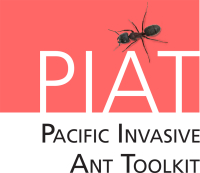Stomach poisons
The two main stomach poisons used in ants are boric acid and hydramethylnon.
Boric acid
Many stomach poisons are boric acid-based, which is a refined version of naturally occurring boron. While this may be marketed as a “natural” solution to ant problems, it should be remembered that boric acid is potentially harmful to humans and other mammals.
The poison is slow acting and accumulates in the gut until it reaches the lethal dose. Ants can detect higher levels of boric acid, so it is essential that a low dose is used in any bait. For this reason it may take two or more months before any reduction in ant numbers is obvious. Low dose poisoning should be repeated every four weeks during this time.
Breakdown in soil
Boric acid breaks down to borate in soil. It is water soluble and is prone to leaching.
Boric acid-based baits such as Exterm-an-ant or No-Ants come in liquid or gel form and are deployed either in bait stations or as a spot treatment at 30 cm intervals where ants have been observed foraging. The toxicant is bound in a sugary matrix, which is attractive to sugar eating ants.
Breakdown in water
Boric acid is soluble in water and may enter waterways by soil leaching.
Non-target effects
Boric acid has very low toxicity to fish as boron occurs naturally in sea water. It can be harmful to borate sensitive plants in higher quantities, as it may absorbed from the soil through the plant’s roots.
Boric acid is moderately toxic to birds.
Information sources
Anon. 1993. R.E.D. Facts Boric Acid. United States Environmental Protection Agency fact sheet.
Hydramethylnon
Detailed information about hydramethylnon and its environmental fate is available in this publication, which is summarised below.
Hydramethylnon is a slow acting stomach poison, administered to ants in the form of granular baits, such as Amdro® and Maxforce® Complete, at low doses to allow workers to pass the toxin on to their nestmates, queen(s) and to larvae before the poison kills them.
The insecticide targets insects with chewing mouthparts (e.g. ants, beetles, dragonflies, grasshoppers and larvae of some butterflies and moths) or sponging mouthparts (e.g. flies). The poison causes a decrease in physical activity and a decrease in respiration followed by death. It is relatively unlikely to affect insects that use other methods of feeding or to be harmful to insects that are only exposed via physical contact rather than consumption of the bait.
Hydramethylnon is typically delivered in a granular bait that is spread with a manual (Scott) spreader. As poison concentrations vary from bait to bait it is essential that you read the manufacturer’s instructions for application rates, measure bait use and apply the correct amount for the area.
Breakdown in soil
In soil, exposure to light is the major means of breakdown for hydramethylnon. Half of the chemical will break down in 5 days in soil exposed to sunlight. In the absence of sunlight, hydramethylnon is very stable and it will take 383 days for half the chemical to break down in the open air.
A white rot fungus Phanerochaete chrysosporium, has been found to break the poison down (with a half-life of 14-25 days). If present, this fungus could assist in the breakdown of the toxicant where ants have carried it below ground into the nest. Hydramethylnon has a low water solubility and high soil absorption, suggesting a low potential to leach from soil into ground water.
Breakdown in water
Hydramethylnon degrades rapidly in water when exposed to sunlight taking approximately one hour for half the compound to break down.
Non-target effects
Great caution should be taken to prevent hydramethylnon-based insecticides from entering water. It can be highly toxic to fish and has a tendency for to accumulate in fatty tissues. However, it should be noted that under normal use conditions aquatic exposure is low because break down by light in water is rapid.
Plants do not uptake the pesticide through their root system. However, residues have been detected in crops. This residue is believed to have arisen from direct contact with the hydramethylnon during application.
Hydramethylnon can be slightly toxic to mammals, but is mostly excreted in the faeces.
As with all pesticides, familiarise yourself with the SDS, always follow the manufacturer’s recommendations and wear appropriate personal protective equipment (such as long sleeved shirt, long pants , chemical resistant gloves, shoes and socks and respiratory protection where necessary).
Information sources
Anon. 2002. Hydramethylnon general fact sheet. USA National Pesticide Information Center technical fact sheet
Bacey. undated. Environmental fate of hydramethylnon. Report for Department of Pesticide Regulation California Environmental Protection Agency Environmental Monitoring Branch
